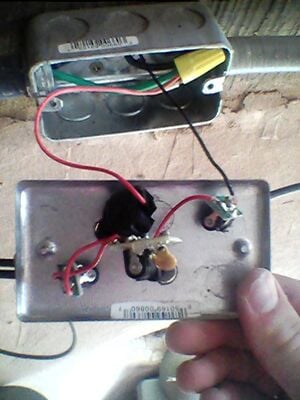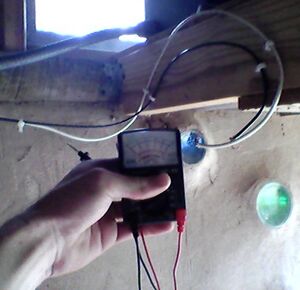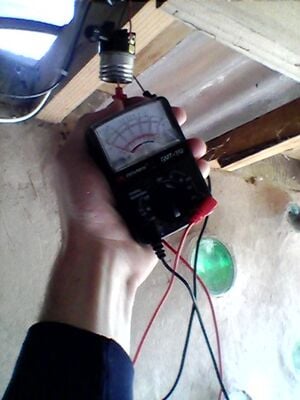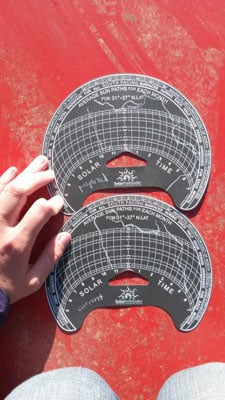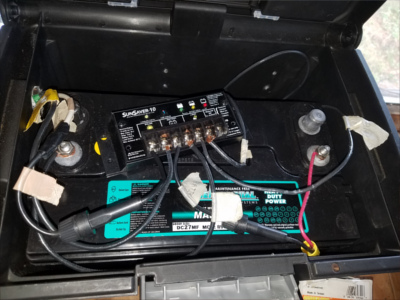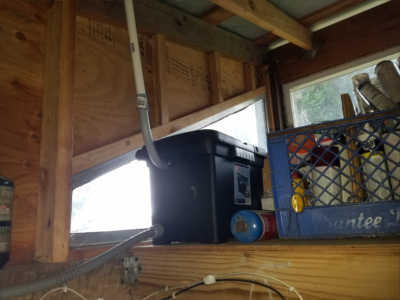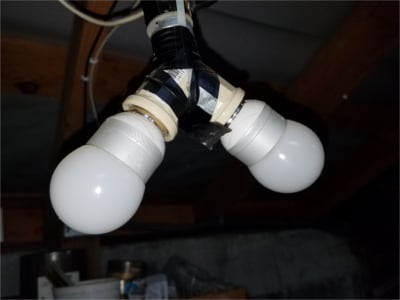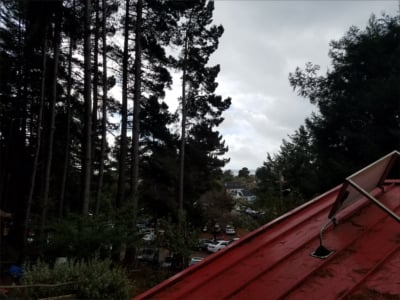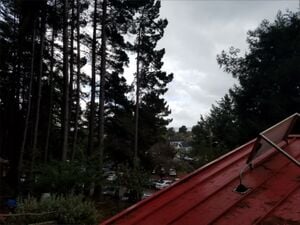
CCAT (Campus Center for Appropriate Technology) is an appropriate technology demonstration house on the Cal Poly Humboldt campus in Arcata, California. Student staff and volunteers work weekly at CCAT to keep it running smoothly. The Greenshed is a building where the workers store tools and work on small projects. The Greenshed solar panel powers a solar lighting system that workers can use to light the shed at night. The solar lighting system was installed in early 2013. There are eight lights powered by the panel that hang inside the shed. CCAT workers would like to use the shed at night, especially when it gets dark early in the day.
Problem statement[edit | edit source]
Problem: CCAT staff let us know the lights in the shed are too dim for workers to use the shed at night.
Our goal is to keep the lights bright at night. This project is for our Engineering 305 class (which ends May 2015). We will be investigating the solar panel, its location, the battery, wiring, and light fixtures for problems. The CCAT workers would like us to try to power their tools with the solar panel. If we find an easy solution to the brightness problem we will look into having the system power tools in the shed, adding a shut-off timer, and a data logging device.
The objective of this project is to:
- Create better lighting in the CCAT tool shed
- Find the best location for the solar panel to intake it's maximum
- Replace and fix any poorly functioning or broken equipment
- Add improvements to the system if time/resources allow (tool powering ability, shut-off timer, data-logging device)
Criteria[edit | edit source]
Below are the Project Evaluation Criteria. We will use them to judge the success of our project. We, the students working on this project, created these criteria with the help of the project manager. These criteria will help everyone working on the project know what is most important (10 being most important/non-negotiable; 1 being least important).
| Criteria | Weight | Contraints |
|---|---|---|
| Funtionality | 10 | Produces and stores enough to sufficiently light the green-shed |
| Safety/Placement | 10 | Must be constructed and placed in risk-free positions (no hazards) |
| Cost | 9 | Does not exceed project budget |
| Maintainability | 8 | Easy to preserve equipment |
| Aethetics | 7 | Looks professional |
| Educational | 5 | Includes educational piece for community/CCAT demonstration house |
| Reproducibility | 5 | Can be reproduced by local builders |
Costs[edit | edit source]
The following table displays the costs for the Green Shed Solar Lighting project. Equipment is purchased after testing so costs may fluctuate.
Proposed budget.
| Quantity | Material | Source | Cost ($) | Total ($) |
|---|---|---|---|---|
| 6 | DC Lights Bulbs | Amazon | $15.99/2 | $47.97 |
| 3 | Leviton Medium Base Turn Knob Socket Interior | Ace Hardware | $4.49 | $13.47 |
| 3 | Leviton Ivory Twin Light Socket Adapter | Interstate Battery | $4.99 | $14.97 |
| 1 | 12 feet Southwire 14YEL-SOLX500 Solid Copper THHN: Solid black and solid white, 10 Gauge | Ace Hardware | $0.79/ft | $9.78 |
| 6 | Cap Connectors | Ace Hardware | $00.25 | $1.50 |
| Total Cost | $87.69 | |||
Rough Timeline[edit | edit source]
| Objectives | Relative Week |
|---|---|
| Group forms | Week 1 Jan 19th |
| Research literature and prepare criteria | Week 3 Feb 2nd |
| Go to CCAT and evaluate project | Week 4 Feb 9th |
| Perform a Solar Pathfinder Analysis(best location Study) | Week 5 Feb 16th |
| Create temporary timeline and budget | Week 6 Feb 23rd |
| Identify best location and test battery, lights, system efficiency with tools (multimeter), consult with CCAT on data logging and order Raspberry PI data logger | Week 7 Mar 3rd |
| Review and identify issue 1. If lights: order new efficient lights 2. If location: order equipment needed to move to new location 3. If battery: unknown | Week 8 Mar 9th |
| If new equipment arrives, install and test | Week 10 Mar 23rd |
| If new equipment arrives, install and test | Week 11 Mar 30th |
| Week 12 Apr 6th | |
| Week 13 Apr 13th | |
| Write up review and handbook for operating the system- |
Week 14 Apr 20th |
| Final evaluation of system | Week 15 Apr 27 |
| Final Report and Appropedia page complete | Week 16 May 4th |
Timeline Changes
Due to a conflicting schedules, our timeline changed throughout the project process. As well, after consulting the CCAT staff, we no longer need to install a motion sensor or Raspberry PI. Our equipment did not arrive until April 29th so our process of installation and testing was delayed and our completed project timeline does not match our original process. Most of our work time was spent researching for parts and reworking failed battery load tests and completing this source page.
Literature Review[edit | edit source]
This is a summation of the literature reviewed to work on the lighting system for the CCAT Green-shed January-May, 2015.
Photovoltaic Systems Overview
The photovoltaic (PV) system converts solar radiation into thermal energy and direct electrical current (DC). The direct current (DC) can be converted to alternate current (AC) through an inverter.[1] A single cell of the PV system module consists of two thin silicon wafers enhanced with other elements that produce a surplus of electrons and when the sunlight strikes this layer of surplus electrons, some release and make their way to the metallic conductors on the silicon surface of the cell, to then flow in the circuit and is pumped out. A module is a group of cells arranged in series and parallel to provide the voltage and amperage output required. A PV system is a stationary system so they are nearly maintenance free, except for any washing needed, which should be done in the morning or evening due to thermal shock breaking the glass.[2]
Energy, Electricity, & Circuits
"OHM's LAW: Voltage (electrical pressure) pushes amperage (current) through a resistance"[3]
Equation: V=IR
V (voltage, sometimes written as E, measured in volts), I (current, measured in amps), R (resistance, measured in ohms)[4]
P=IV
Off Grid Power
CCAT's photovoltaic system is classified as a stand-alone system. This system connects the battery to the modules through a charge controller. This controller switches off the PV array when the battery is fully charged. This battery must be large enough to store enough charge for night use, when the lights are necessary. There is no back-up supply or main grid connection.[5]
Orientation and Location of Panel
Power output by the module will change based on the angle of sunlight striking the module.[6] The output will rise as sunlight striking angle increases until the sun reaches its peak, then decreases as the sun goes down and the angle decreases once again. All modules will catch the maximum sunlight if oriented correctly, thus, in the winter, angle it to your latitude plus 23 degrees (precessional angle of the sun), while in the summer, the angle should include your latitude minus 23 degrees.[2]
Batteries
Batteries provide storage of energy beyond household needs, until charging sources can no longer provide energy to household. Once they are full, no more energy will flow in because batteries are finite in capacity. Safety devices, such as fuses, should be used between the power source and the system because they help prevent overheating from excess energy flow from the batteries and burning a home down.[2]
Inverters
Batteries release DC electricity, because AC cannot be stored. However, AC is more easily transmitted and is used by the world's power grids. Inverters help invert the DC to AC which is a more beneficial source of electricity. AC lights are mass-produced, which means they are cheaper and more available at a higher quality and selection than DC appliances. AC also allows for more conventional techniques as more lighting is easier and cheaper to install for a full-home system. However, with our simple circuit, DC is more reasonable as is it low power and off-grid.[2]
PV Controllers
Controllers stop the charging process of the battery when it is at full capacity because the battery can experience damage or be destroyed if overcharged too often. Controllers meter in the energy more slowly as the battery approaches 100% full capacity. They also prevent the reverse current flow that occurs with PV modules over night.[2]
Monitors
A monitor manages the system's state of charge.[2]
Factors Affecting Output
Standard test conditions: Industry conditions under which a solar panel is tested and a production tolerance of +/-5%, meaning that the total wattage expressed is 95 Watts/ 100 Watt module.[6]
Temperature: Module output power reduces as modular temperature increases, while they increase power output at colder temperatures.[6]
Dirt and dust: Accumulation of the substances blocks sunlight, which reduces the final output.
Wiring and mismatch: Inconsistencies in performance from one module to another results in a 2% loss in the system's power.
DC to AC conversion loss: The DC power generated by the photovoltaic system loses power during the conversion process.
Weather/Climate: The panels need solar radiation to produce energy, shade (by objects or clouds) decreases output.[7]
Wire and Cables
Cables identify the wire gauge and number of wires inside of them. The wires inside vary in ampacity which is the measure of the total current a wire can safely carry (match wire ampacity to that of the circuit size). This ampacity varies with the size of the wiring.[8]
Common Cable Problems
Problem 1 Cables running across joists or studs which is forbidden in electrical codes.
Solution 1 Drill holes in framing at least 2" from edges that are exposed.
Problem 2 Loosely hung cables along joists or studs.
Solution 2 Anchor cable with staples along framing at least 1 1/4" from the edge.
Problem 3 Cable threaded through joists or studs is close to edge of framing and can be damaged by nails or screws.
Solution 3 Install nail gun guards to protect the cables from damage.
Problem 4 Unclamped cable enters an electrical box where edges can rub against the sheathing and damage the wires.
Solution 4 Anchor the cable to the box with a cable clamp.
Problem 5 Bare wire extends past the screw terminal where exposed wire can cause a short circuit if touched by other circuit wire or the metal box.
Solution 5 Clip and reconnect as the wire should wrap completely around the screw terminal.
Problem 6 Nicks and scratches in bare wires.
Solution 6 Clip away damaged portion and re-strip the wire and reconnect.[8]
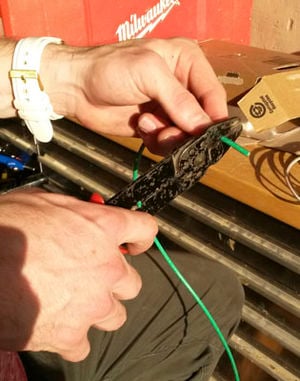
Operation[edit | edit source]
This is the how to section explaining how and when to maintain the new system in the greenshed with the new added features.
Installation
This process involved wiring the new wires from the main lines connecting the three parallel circuits (black and white circuit wires). This involved using a maximum wire connector to create a connection of the main line. Then using coaxial cable staples, we mounted the wiring along the building structure to provide attachment of loose wires. We also used zip ties to hold the wires together to provide more consolidation and a minimal area usage by the wiring. Then after stripping the other end of the wires we connected the white wire to a smaller gauged red transition wire, through a minimum wire connector, and this wire was then connected to the golden screw terminal on the knob socket. While the black wire was connected to a smaller gauged blacked wire through a minimum wire connector, which is connected to the silver screw terminal. This socket then allows the light socket adapter to screw into it, from here the lights screw in to light up the building.
Maintenance
The system needs to be properly maintained in order to run properly and at full power. For full detail on the past full maintenance of the PV system project, refer to CCAT greenshed solar lighting#Maintenance and Next steps.
Schedule
- Yearly
- Perform checks on the SunSaver
- Test voltage/amperes in full sun
- Check all terminals and wires for loose, broken, corroded or burnt connections or components
- Monthly
- Clear PV panel on roof of any debris
Instructions
General maintenance includes:
- The PV panel tasks and signs of damage
Should a problem with the lighting come up, the wiring can easily be checked via the box on the underside of the solar panel.
- The yearly SunSaver-10 PV controller tasks
- Any battery testing and replacement
- Light failure dimming analysis and testing
New maintenance tasks include:
- Continuing general maintenance listed above
- Monitor the new LED DC lights for dimming and failure
- If failure, examine wiring connections, battery load and/or solar panel input
- If dimming, test socket load output.
- Socket Output Load Testing
Disconnect the fixture wires if you find the connections were good and to check the continuity. With the meter set on the ohms function, check for continuity between the white fixture wire and the metal shell inside the light socket. The meter will display "0.000" on its LCD if there is continuity. If the socket is bad, the LCD will display "O.L." Then check for continuity between the black fixture wire and the brass button in the lamp socket. The LCD will either display "0.000" or "O.L." --If the socket checks out OK but the light still does not work, the brass contact of the socket is not making contact with the base of the bulb and needs to be pried away from the base of the socket.
Read more at:
- http://web.archive.org/web/20161227093818/http://www.ehow.com/how_7882922_use-multimeter-test-light-fixtures.html
- http://www.instructables.com/id/EVERYONE-Needs-a-Multi-Meter/step5/Light-bulbs/
Video[edit | edit source]
Conclusion[edit | edit source]
Testing
The system requires each feature functioning to run, so we tested every feature that may be the cause of the lights running dim. We tested the battery load, the lights in the system at the start, and the position of the solar panel.
Processes
Battery Load Test: The battery load test was necessary to confirm the battery was still providing it's full capacity. A battery load test involves initially covering the panel to stop anymore load input after at least 12 hours of solar charging. Then run the system lights until the battery load is run dry by the output lighting source. This will provide the total hours needed to drain the total energy supplied by the battery. This number can be used with the total given voltage and amp-hours for the battery (12V x 12 Ah = 144 Wh).
Light Power Test:
Although CCAT requested for lighting through sockets, we tested the replaced hard-wired lights to show that they still produced their full power output. This testing was done with the help of the Humboldt State Physics lab staff and equipment. Professors Terry Halmo and Tyler Hooker tested that the lights could produce more Wattage (5 V x 0.8 A = 4 W) than what they were producing in the greenshed through the PV system (2.8 V x 1.2 A = 3.36 W). These results were found through cutting down a light and testing the circuit through its open wires exposed. We have installed DC lights that function at 5 W.
Solar Pathfinder:
Location of Sunlight throughout a day: This test involved showing up hourly, and recording the location of the sunlight along the roof to show which location received the most solar insolation. The following figures are based on the sunrise-sunset period of May 1, 2015. All pictures taken earlier than 10 AM showed similar solar insolation to that of 10 AM. The sunset to sunrise period is 6 AM to 8 PM.
-
10 AM
-
1 PM
-
3 PM
-
5 PM
Results
Battery Load Test:
This test provided the results using 6 (5 Watt) LED lights as a load on the battery, which ran for 4 hours and 30 minutes (4.5 hours). The 144 Wh battery should last for 4 hours and 48 minutes (4.8 hours). This proves that the battery is performing at an efficiency of 93.75% which is great enough to continue to be used. -144 Wh / 30 W = 4.8 hours-
Light Power Test:
The hardwired lights were able to produce up to 5 volts/ 0.8 amps. This test was performed under conditions in the Cal Poly Humboldt Physics lab using a dummy load test machine (meter).
Solar Pathfinder:
Location of Sunlight throughout a day: This test involved showing up hourly, and recording the location of the sunlight along the roof to show which location received the most solar insolation. The following figures are based on the sunrise-sunset period of May 1, 2015. All pictures taken earlier than 10 AM showed similar solar insolation to that of 10 AM. The sunset to sunrise period is 6 AM to 8 PM.
- Roof Insolation
-
10 AM
-
1 PM
-
3 PM
-
5 PM
Solar Pathfinder:
-
Using the Solar Pathfinder
This test provided the results needed to identify whether the solar panel should be moved to the most North location on the roof of the greenshed for more sun hours. The following image shows the diagram reading taken from the south end of the roof (green marking line), and the north end (red marking line). Due to tree blockage, the sun does not hit the panel until the afternoon each day (south end).
- South End of Roof
Total Solar Insolation = Trial 1: 65.3 kWh/m2/day
- North End of Roof
Total Solar Insolation = Trial 1: 61.8 kWh/m2/day
Trial 2
Discussion
This project was a success in achieving function and increased power from the lighting source to provide the greenshed with more light than provided beforehand. After replacing the hardwired lights with a socketed circuit, we installed LED lights that provide more wattage usage and greater illumination for the shed area. The solar panel will not be moved as it is uneccesary with the sufficient power output being provided to the light sources. The battery is in good shape to sustain another year at least and is located in the same position. This project was designed to construct a system with extraordinary features such as a Raspberry PI, however, through consulting and testing, we have analyzed that only switching the light output source is sufficient enough to meet the criteria (wants and needs) of CCAT.
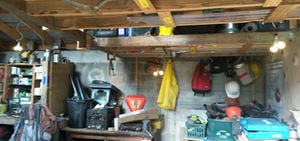
Next Step
For future projects regarding the shed's solar lighting system, it is important to work with the CCAT staff to understand their priorities regarding any project involving photovoltaic equipment. This is due to the minor additions that may be included to the system such as a Raspberry PI and motion sensor. CCAT is a center of appropriate demonstration of technology, it is important to keep the tools and projects under a simple design so other may follow or continue its use with ease. Another future inclusion for this project is adding an inverter to convert the electricity from DC to AC if the process of ordering new light bulbs becomes a difficult task. Lastly, if the lights fail, then the option of installing the old hardwired lights back is still an option because they were uninstalled to maintain connection and to have an easy re-installation process.
Update October 2016[edit | edit source]
As of October 2016, the PV solar panel and lighting system located on the CCAT greenshed is operating sufficiently. The CCAT staff and volunteer are satisfied with the performance of the system. The power generated by the PV panel is more than sufficient to meet the lighting needs for the shed. Previous issues with the light output being too dim were resolved by replacing the initial hardwired lights with socketed LED bulbs. The LED lights are able to remain on for more than 4 hours at a time without signs of dimming. Potential additions to the system, such as the ability to charge power tools, and the installation of a data logger and motion sensor have not happened. Currently the power tools are charged by an extension chord connected to the main house. In the future CCAT staff and volunteers would still like to include an inverter in order to use AC current to charge the power tools. As for the data logger and motion sensor, CCAT staff does not feel they are necessary additions to the system at this time.
View inside battery box of battery and voltage regulator
Location of battery box inside green shed
Socketed LED bulbs inside green shed
PV solar panel on green shed roof
References[edit | edit source]
- ↑ Tiwari, G. N.(2006). Solar Energy Technology Advances. New York: New York.
- ↑ 2.0 2.1 2.2 2.3 2.4 2.5 Schaeffer, John. (1994). Solar Living Source Book. 8th ed. White River Junction, Vermont.
- ↑ Sullivan, Daniel (2011). "What are VOLTs, OHMs & AMPs?" Youtube, <https://www.youtube.com/watch?v=zYS9kdS56l8> (Feb. 2, 2015).
- ↑ Turner, R.P.(1978).Solar Cells and Photocells, Indianapolis, Indiana.
- ↑ Reddy, P. Jayarama.(2010). Science Technology of Photovoltaics. 2nd ed. Hyderabad, India.
- ↑ 6.0 6.1 6.2 (2001)."A GUIDE TO PHOTOVOLTAIC (PV) SYSTEM DESIGN AND INSTALLATION".Energy Council of Canada <http://web.archive.org/web/20180810202151/http://www.energy.ca.gov/reports/2001-09-04_500-01-020.PDF>.(Feb. 9,2015)
- ↑ Solar Energy International (2004).Photovoltaics: Design and Installation Manual, Gabriola Island, British Columbia.
- ↑ 8.0 8.1 Creative Publishing. 2005. "The Complete Guide to Home Wiring". Black and Decker. Minneapolis, Minnesota.
